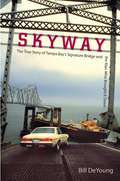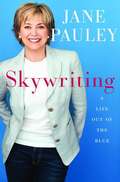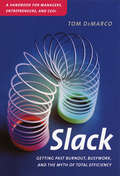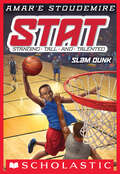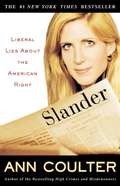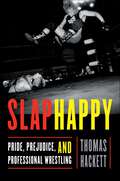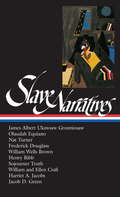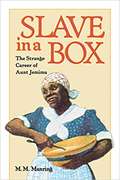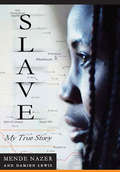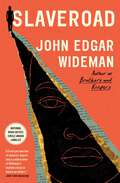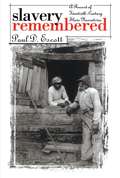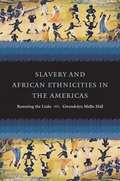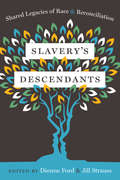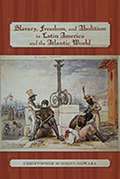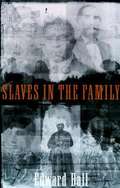- Table View
- List View
Skymeadow: Notes from an English Gardener
by Charlie Hart'A love letter to English horticulture written by a passionate gardener. A must-read for anyone who has dreamt of cultivating their own patch of land' Jane Perrone'Skymeadow is a fascinating book . . . Every flower, every passing bud, every change in the season is described with rapture' Jilly CooperWhen Charlie Hart first visited Peverels, a small farmhouse that sits lazily on the lip of a hill running down into the Peb Valley, he was at breaking point, grieving the loss of his father and anxious about the impending death of his mother. He and his wife Sybilla felt that their London life had been steadily growing in noise: the noise of grief, the noise of busyness, the noise that comes from the expectations of others and, for Charlie, the constant clamour of dissatisfaction at work. At Peverels, Charlie found an expanse of untouched meadowland, the perfect setting for an audacious garden. Charlie felt an unquenchable urge to dig, to create something. The days he spent wrestling with the soil in the rose garden were the days in which he mourned the loss of his parents. Gardening has taught him that you can dig for victory, but you can also dig for mental health. As the garden formed around Charlie, he buried his fears and anxieties within it. A garden that is now known as Skymeadow and grows with a lusty, almost biblical vigour.In Skymeadow, Charlie seamlessly weaves together his own memoir with that of his garden. The result is a lyrical and incisive story of mental health at an all-time low, the healing powers of digging and, ultimately, a celebration of nature.
Skyway: The True Story of Tampa Bay's Signature Bridge and the Man Who Brought It Down
by Bill DeYoungOn the morning of May 9, 1980, harbor pilot John Lerro was guiding a 600-foot freighter, the Summit Venture, into Tampa Bay. Directly in the ship’s path was the Sunshine Skyway Bridge--two ribbons of concrete, steel, and asphalt that crossed fifteen miles of open bay. Suddenly, a violent weather cell reduced visibility to zero at the precise moment when Lerro attempted to direct the 20,000-ton vessel underneath the bridge. Unable to stop or see where he was going, Lerro drove the ship into a support pier; the main span splintered and collapsed 150 feet into the bay. Seven cars and a Greyhound bus fell over the broken edge and into the churning water below. Thirty-five people died.Skyway tells the entire story of this horrific event, from the circumstances that led up to it through the years-long legal proceedings that followed. Through personal interviews and extensive research, Bill DeYoung pieces together the harrowing moments of the collision, including the first-person stories of the survivors, and remembers those whose lives were cut short by the events of that fateful day. Similarly, DeYoung details the downward spiral of Lerro’s life, his vilification in the days and weeks that followed the accident, and his obsession with the tragedy well into his painful last years.DeYoung also offers a history of the ill-fated bridge, from its construction in 1954, through the addition of a second parallel span in 1971, to its eventual replacement. He discusses the sinking of a Coast Guard cutter a mere three months before Skyway collapsed and the Department of Transportation’s dire warnings about the bridge’s condition. The result is a vividly detailed portrait of the rise and fall of a Tampa Bay landmark.
Skywriting
by Jane Pauley“Truth arrives in microscopic increments, and when enough has accumulated–in a moment of recognition, you just know. You know because the truth fits. I was the only member of my family to lack the gene for numbers, but I do need things to add up. Approaching midlife, I became aware of a darkening feeling–was it something heavy on my heart, or was something missing? Grateful as I am for the opportunities I’ve had, and especially for the people who came into my life as a result, I couldn’t ignore this f...
Slack
by Tom DemarcoTo most companies, efficiency means profits and growth. But what if your "efficient" company--the one with the reduced headcount and the "stretch" goals--is actually slowing down and losing money? What if your employees are burning out doing the work of two or more people, leaving them no time for planning, prioritizing, or even lunch? What if you're losing employees faster than you can hire them? What if your superefficient company is suddenly falling behind?Tom DeMarco, a leading management consultant to both Fortune 500 and up-and-coming companies, has discovered a counterintuitive principle that explains why efficiency improvement can sometimes make a company slow. If your real organizational goal is to become fast (responsive and agile), then he proposes that what you need is not more efficiency, but more slack. What is "slack"? Slack is the degree of freedom in a company that allows it to change. It could be something as simple as adding an assistant to a department, letting high-priced talent spend less time at the photo copier and more time making key decisions. Slack could also appear in the way a company treats employees: instead of loading them up with overwork, a company designed with slack allows its people room to breathe, increase effectiveness, and reinvent themselves.In thirty--three short chapters filled with creative learning tools and charts, you and your company can learn how to: make sense of the Efficiency/Flexibility quandary run directly toward risk instead of away from it strengthen the creative role of middle management make change and growth work together for even greater profitsA innovative approach that works for new- and old-economy companies alike, this revolutionary handbook will debunk commonly held assumptions about real-world management, and give you and your company a brand-new model for achieving and maintaining true effectiveness--and a healthier bottom line.From the Hardcover edition.
Slackjaw
by Jim KnipfelIt wasn't until he was in his early twenties that doctors discovered that Jim Knipfel's nearsightedness was the result of an untreatable rare genetic eye disease known as retinitis pigmentosa, which, they said, would leave him blind within a few short years.
Slacks and Calluses: Our Summer in a Bomber Factory
by Clara Marie Allen Constance BowmanIn 1943 two spirited young teachers decided to do their part for the war effort by spending their summer vacation working the swing shift on a B-24 production line at a San Diego bomber plant. Entering a male-dominated realm of welding torches and bomb bays, they learned to use tools that they had never seen before, live with aluminum shavings in their hair, and get along with supervisors and coworkers from all walks of life. They also learned that wearing their factory slacks on the street caused men to treat them in a way for which their "dignified schoolteacher-hood" hadn't prepared them. At times charming, hilarious, and incredibly perceptive, Slacks and Calluses brings into focus an overlooked part of the war effort, one that forever changed the way the women were viewed in America.From the Trade Paperback edition.
Slam Dunk: Slam Dunk (STAT #3)
by Amar'e StoudemireFrom the NBA superstar: “A series of chapter books that celebrate sports, smarts and friendship . . . Amar’e is a likable protagonist.” —Kirkus ReviewsEleven-year-old Amar’e Stoudemire has been playing so much basketball lately it feels like he doesn’t have time to do all the things he used to love. His team needs him because he is one of the best players on the court despite also being one of the youngest. When some of the older kids get on Amar’e for not being able to dunk, he sets a goal to make that happen soon. But when Amar’e’s playing time is put on hold, he’ll have to come to terms with all of the other things he’s been neglecting in this exciting series based on the life of All-Star NBA sensation Amar’e Stoudemire, who overcame many obstacles to become one of the most popular figures in sports today.“The b-ball action and jargon flies fast and free . . . and hard work leads to triumph on the court.” —BooklistPraise for the series“Will keep basketball fans riveted . . . Amar’e’s voice is refreshingly real.” —Publishers Weekly
Slander
by Ann Coulter"The immutable fact of politics in America is this: liberals hate conservatives." Ann Coulter, whose examination of the Clinton impeachment was a major national bestseller and earned widespread praise, now takes on an even tougher issue. At a time when Democrats and Republicans should be overwhelmingly congenial, American political debate has become increasingly hostile, overly personal, and insufferably trivial. Whether conducted in Congress or on the political talk shows, played out at dinners or cocktail parties, politics is a nasty sport. At the risk of giving away the ending: It's all liberals' fault. Cultlike in their behavior, vicious in their attacks on Republicans, and in almost complete control of mainstream national media, the left has been merciless in portraying all conservatives as dumb, racist, power hungry, homophobic, and downright scary. This despite the many Republican accomplishments of the last few decades, as well as the Bush administration's expert handling of the country's affairs in the wake of the worst attacks on American soil and of the war that followed. With incisive reasoning and meticulous research, Ann Coulter examines the events and personalities that have shaped modern political discourse-- the bickering, backstabbing, and name-calling that have made cultural mountains out of partisan molehills. She demonstrates how the media, especially, are biased-- and usually wrongheaded-- and have done all in their power to obfuscate the issues and the people behind them, bending over backward to villainize and belittle the right, while rarely missing an opportunity to praise the left. Perhaps if conservatives had had total control over every major means of news dissemination for a quarter century, they would have forgotten how to debate, too, and would just call liberals stupid and mean. But that's an alternative universe. In this universe, the public square is wall-to-wall liberal propaganda. Refreshingly honest and unerringly timely, Slander continues where Bernard Goldberg's number one bestselling Bias left off.
Slaphappy: Pride, Prejudice, and Professional Wrestling
by Thomas HackettSlaphappy is reporter Thomas Hackett's penetrating look at the world of professional wrestling, for those who love the spectacle and for the sport's skeptics and the uninitiated. Through interviews with wrestlers, promoters, and fans, Hackett explores the full range of issues that swirl around wrestling culture -- fame, masculinity, violence, aggression, performance, and play. Among the lessons of professional wrestling is that deceit is a fundamental fact of American life. And yet, paradoxically, the one thing wrestling isn't is dishonest. Although wrestlers play pretend, wrestling itself doesn't pretend to be anything other than what it is -- fantastically absurd, a very American kind of madness. Celebrity-obsessed, pathologically narcissistic, murderously competitive, it both epitomizes and parodies the delusional egoism at the heart of the culture.More than that, wrestling provides its fans and performers a medium for thinking about "getting over" in America today. This spectacle of excess may be the apotheosis of American imbecility, but it is also defiant, hopeful, liberating, and unifying -- a throwback to the raucous pleasures of early theater. Fans aren't detached connoisseurs, looking satirically down on life, concealing their anxieties in the cold comforts of irony. They are total participants in a carnival of their own making, shouting epithets, throwing chairs, expatiating their worries in a crowd's triumphant foolishness.It is, Slaphappy concludes, all the stuff of human culture. Where does fantasy end and reality begin? Where does the performance stop and life take over? Writing with affection and discernment, Hackett gets deep into the culture, discovering that the make-believe competition of wrestling is indeed "real" for millions of young men -- real in the sense that something real and important is at stake: their worth as men.
Slash: The Autobiography
by Anthony Bozza SlashFrom one of the greatest rock guitarists of our era comes a memoir that redefines sex, drugs, and rock 'n' roll He was born in England but reared in L.A., surrounded by the leading artists of the day amidst the vibrant hotbed of music and culture that was the early seventies. Slash spent his adolescence on the streets of Hollywood, discovering drugs, drinking, rock music, and girls, all while achieving notable status as a BMX rider. But everything changed in his world the day he first held the beat-up one-string guitar his grandmother had discarded in a closet. The instrument became his voice and it triggered a lifelong passion that made everything else irrelevant. As soon as he could string chords and a solo together, Slash wanted to be in a band and sought out friends with similar interests. His closest friend, Steven Adler, proved to be a conspirator for the long haul. As hairmetal bands exploded onto the L.A. scene and topped the charts, Slash sought his niche and a band that suited his raw and gritty sensibility. He found salvation in the form of four young men of equal mind: Axl Rose, Izzy Stradlin, Steven Adler, and Duff McKagan. Together they became Guns N' Roses, one of the greatest rock 'n' roll bands of all time. Dirty, volatile, and as authentic as the streets that weaned them, they fought their way to the top with groundbreaking albums such as the iconic Appetite for Destruction and Use Your Illusion I and II. Here, for the first time ever, Slash tells the tale that has yet to be told from the inside: how the band came together, how they wrote the music that defined an era, how they survived insane, never-ending tours, how they survived themselves, and, ultimately, how it all fell apart. This is a window onto the world of the notoriously private guitarist and a seat on the roller-coaster ride that was one of history's greatest rock 'n' roll machines, always on the edge of self-destruction, even at the pinnacle of its success. This is a candid recollection and reflection of Slash's friendships past and present, from easygoing Izzy to ever-steady Duff to wild-child Steven and complicated Axl. It is also an intensely personal account of struggle and triumph: as Guns N' Roses journeyed to the top, Slash battled his demons, escaping the overwhelming reality with women, heroin, coke, crack, vodka, and whatever else came along. He survived it all: lawsuits, rehab, riots, notoriety, debauchery, and destruction, and ultimately found his creative evolution. From Slash's Snakepit to his current band, the massively successful Velvet Revolver, Slash found an even keel by sticking to his guns. Slash is everything the man, the myth, the legend, inspires: it's funny, honest, inspiring, jaw-dropping . . . and, in a word, excessive.
Slave Hunter: One Man's Global Quest to Free Victims of Human Trafficking
by Aaron Cohen Christine BuckleyFrom living the rock star life to wading through the world's war zones, refugee camps, and brothels, Aaron Cohen left behind his closest friends, his dying father, and his partnership with a legendary musician to take on treacherous rescue missions in search of modern-day slaves.
Slave Narratives
by William L. Andrews Henry Louis GatesThe ten works collected in this volume demonstrate how a diverse group of writers challenged the conscience of a nation and laid the foundations of the African American literary tradition by expressing their in anger, pain, sorrow, and courage.Included in the volume: Narrative of the Most Remarkable Particulars in the Life of James Albert Ukawsaw Gronniosaw; Interesting Narrative of the Life of Olaudah Equiano; The Confessions of Nat Turner; Narrative of the Life of Frederick Douglass; Narrative of William W. Brown; Narrative of the Life and Adventures of Henry Bibb; Narrative of Sojouner Truth; Ellen and William Craft's Running a Thousand Miles for Freedom; Harriet Jacobs' Incidents in the Life of a Slave Girl and Narrative of the Life of J. D.Green.
Slave in a Box: The Strange Career of Aunt Jemima (American South)
by Maurice M. ManringManring suggests that by documenting Aunt Jemima's fascinating evolution, however, we can learn important lessons about our collective cultural identity.
Slave: My True Story
by Damien Lewis Mende NazerMende Nazer lost her childhood at age twelve, when she was sold into slavery. It all began one horrific night in 1993, when Arab raiders swept through her Nuba village, murdering the adults and rounding up thirty-one children, including Mende. Mende was sold to a wealthy Arab family who lived in Sudan's capital city, Khartoum. So began her dark years of enslavement. Her Arab owners called her "Yebit," or "black slave." She called them "master." She was subjected to appalling physical, sexual, and mental abuse. She slept in a shed and ate the family leftovers like a dog. She had no rights, no freedom, and no life of her own. Normally, Mende's story never would have come to light. But seven years after she was seized and sold into slavery, she was sent to work for another master-a diplomat working in the United Kingdom. In London, she managed to make contact with other Sudanese, who took pity on her. In September 2000, she made a dramatic break for freedom. Slave is a story almost beyond belief. It depicts the strength and dignity of the Nuba tribe. It recounts the savage way in which the Nuba and their ancient culture are being destroyed by a secret modern-day trade in slaves. Most of all, it is a remarkable testimony to one young woman's unbreakable spirit and tremendous courage.
Slave: The True Story of a Girl's Lost Childhood and Her FIght for Survival
by Damien Lewis Mende NazerMende Nazer's happy childhood was cruelly cut short at the age of twelve when the Mujahidin rode into her village in the remote Nuba mountains of Sudan. They hacked down terrified villagers, raped the women and abducted the children. Mende was them. She was taken and sold to an Arab woman in Khartoum. She was stripped of her name and her freedom. For seven long years she was kept as a domestic slave, an 'abid', without any pay or a single day off. Her food was the leftover scraps and her bed was the floor of the locked-up garden shed. She endured this harsh and lonely existence without knowing whether her family was alive or dead, for seven long years. Passed on by her master, like a parcel, to a relative in London, Mende eventually managed to escape to freedom. Slave is a shocking first-person insight into the modern day slave trade. It is also a fascinating memoir of an African childhood and a moving testimony to a young girl's indomitable spirit in the face of adversity.
Slave: The True Story of a Girl's Lost Childhood and Her FIght for Survival
by Damien Lewis Mende NazerMende Nazer's happy childhood was cruelly cut short at the age of twelve when the Mujahidin rode into her village in the remote Nuba mountains of Sudan. They hacked down terrified villagers, raped the women and abducted the children. Mende was them. She was taken and sold to an Arab woman in Khartoum. She was stripped of her name and her freedom. For seven long years she was kept as a domestic slave, an 'abid', without any pay or a single day off. Her food was the leftover scraps and her bed was the floor of the locked-up garden shed. She endured this harsh and lonely existence without knowing whether her family was alive or dead, for seven long years. Passed on by her master, like a parcel, to a relative in London, Mende eventually managed to escape to freedom. Slave is a shocking first-person insight into the modern day slave trade. It is also a fascinating memoir of an African childhood and a moving testimony to a young girl's indomitable spirit in the face of adversity.
Slaveroad
by John Edgar Wideman&“Master of language&” (The New York Times) John Edgar Wideman uses his unique generational position to explore what he calls the &“slaveroad,&” offering &“a fresh perspective of slavery&’s impact and a confirmation of Wideman&’s exalted status in American letters&” (New York magazine).John Edgar Wideman&’s Slaveroad is a groundbreaking work of &“bruising candor and obsessive originality&” (The Wall Street Journal). For centuries, the buying and selling of human beings was legal, and millions of Africans were kidnapped then forcibly transported across the Atlantic Ocean to serve as slaves. The enduring legacies of this slave road traffic—denied, unacknowledged, misunderstood, repressed—continue to poison the experiences and journeys of all Americans. In a section of &“Slaveroad,&” called &“Sheppard,&” William Henry Sheppard, a descendant of enslaved Virginians, travels back to Africa where he works as a missionary, converting Africans to Christianity alongside his Southern white colleague. Wideman imagines drinking afternoon tea with Lucy Gant Sheppard, William&’s wife, who was on her own slaveroad, as she experienced her husband&’s adultery with the African women he was trying to convert. In &“Penn Station,&” Wideman&’s brother, after being confined forty-four years in prison, travels from Pittsburgh to New York. As Wideman awaits his brother, he asks, &“How will I distinguish my brother from the dead. Dead passengers on the slaveroad.&” &“A blend of memoir, fiction, history&” (The Millions), Slaveroad is a book that will inform, challenge, and surprise Wideman fans as well as newcomers to his writing.
Slavery Remembered
by Paul D. EscottSlavery Remembered is the first major attempt to analyze the slave narratives gathered as part of the Federal Writers' Project. Paul Escott's sensitive examination of each of the nearly 2,400 narratives and his quantitative analysis of the narratives as a whole eloquently present the differing beliefs and experiences of masters and slaves. The book describes slave attitudes and actions; slave-master relationships; the conditions of slave life, including diet, physical treatment, working conditions, housing, forms of resistance, and black overseers; slave cultural institutions; status distinctions among slaves; experiences during the Civil War and Reconstruction; and the subsequent life histories of the former slaves.An important contribution to the study of American slavery, Slavery Remembered is an ideal classroom text for American history surveys as well as more specialized courses.Slavery Remembered is an important contribution to the study of American slavery and, because of its brevity and clarity, an ideal classroom text for American history surveys as well as more specialized courses.-->
Slavery and African Ethnicities in the Americas: Restoring the Links
by Gwendolyn Midlo HallDrawing on a wide range of materials in four languages as well as on a lifetime of study of slave groups in the New World, Gwendolyn Midlo Hall explores the persistence of African ethnic identities among the enslaved over four hundred years of the Atlantic slave trade. Hall traces the linguistic, economic, and cultural ties shared by large numbers of enslaved Africans, showing that despite the fragmentation of the diaspora, many ethnic groups retained enough cohesion to communicate and to transmit elements of their shared culture.
Slavery's Descendants: Shared Legacies of Race and Reconciliation
by Jill StraussRace remains a potent and divisive force in our society. Whether it is the shooting of minority people by the police, the mass incarceration of people of color, or the recent KKK rallies that have been in the news, it is clear that the scars from the United States’ histories of slavery and racial discrimination run too deep to simply be ignored. But what are the most productive ways to deal with the toxic and torturous legacies of American racism? Slavery’s Descendants brings together contributors from a variety of racial backgrounds, all members or associates of a national racial reconciliation organization called Coming to the Table, to tell their stories of dealing with America’s racial past through their experiences and their family histories. Some are descendants of slaveholders, some are descendants of the enslaved, and many are descendants of both slaveholders and slaves. What they all have in common is a commitment toward collective introspection, and a willingness to think critically about how the nation’s histories of oppression continue to ripple into the present, affecting us all. The stories in Slavery’s Descendants deal with harrowing topics—rape, lynching, cruelty, shame—but they also describe acts of generosity, gratitude, and love. Together, they help us confront the legacy of slavery to reclaim a more complete picture of U.S. history, one cousin at a time. Funding for the production of this book was provided by Furthermore, a program of the J. M. Kaplan Fund (https://www.furthermore.org).
Slavery, Freedom, and Abolition in Latin America and the Atlantic World
by Christopher Schmidt-NowaraThe last New World countries to abolish slavery were Cuba and Brazil, more than twenty years after slave emancipation in the United States. Why slavery was so resilient and how people in Latin America fought against it are the subjects of this compelling study. Beginning with the roots of African slavery in the fifteenth- and sixteenth-century Iberian empires, this work explores central issues, including the transatlantic slave trade, labor, Afro-Latin American cultures, racial identities in colonial slave societies, and the spread of antislavery ideas and social movements. A study of Latin America, this work, with its Atlantic-world framework, will also appeal to students of slavery and abolition in other Atlantic empires and nation-states in the early modern and modern eras.
Slavery, Race, and Conquest in the Tropics
by Robert E. MaySlavery, Race, and Conquest in the Tropics challenges the way historians interpret the causes of the American Civil War. Using Abraham Lincoln and Stephen Douglas's famed rivalry as a prism, Robert E. May shows that when Lincoln and fellow Republicans opposed slavery in the West, they did so partly from evidence that slaveholders, with Douglas's assistance, planned to follow up successes in Kansas by bringing Cuba, Mexico, and Central America into the Union as slave states. A skeptic about 'Manifest Destiny', Lincoln opposed the war with Mexico, condemned Americans invading Latin America, and warned that Douglas's 'popular sovereignty' doctrine would unleash US slaveholders throughout Latin America. This book internationalizes America's showdown over slavery, shedding new light on the Lincoln-Douglas rivalry and Lincoln's Civil War scheme to resettle freed slaves in the tropics.
Slaves in the Family
by Edward BallThe Ball family hails from South Carolina―Charleston and thereabouts. Their plantations were among the oldest and longest-standing plantations in the South. Between 1698 and 1865, close to four thousand black people were born into slavery under the Balls or were bought by them. In Slaves in the Family, Edward Ball recounts his efforts to track down and meet the descendants of his family's slaves. Part historical narrative, part oral history, part personal story of investigation and catharsis, Slaves in the Family is, in the words of Pat Conroy, "a work of breathtaking generosity and courage, a magnificent study of the complexity and strangeness and beauty of the word ‘family.'"<P><P> Winner of the National Book Award
Slavish Shore: The Odyssey of Richard Henry Dana Jr.
by Jeffrey L. AmestoyIn 1834 Harvard dropout Richard Henry Dana Jr. became a common seaman, and soon his Two Years Before the Mast became a classic. Literary acclaim did not erase the young lawyer's memory of floggings he witnessed aboard ship or undermine his vow to combat injustice. Jeffrey Amestoy tells the story of Dana's determination to keep that vow.

